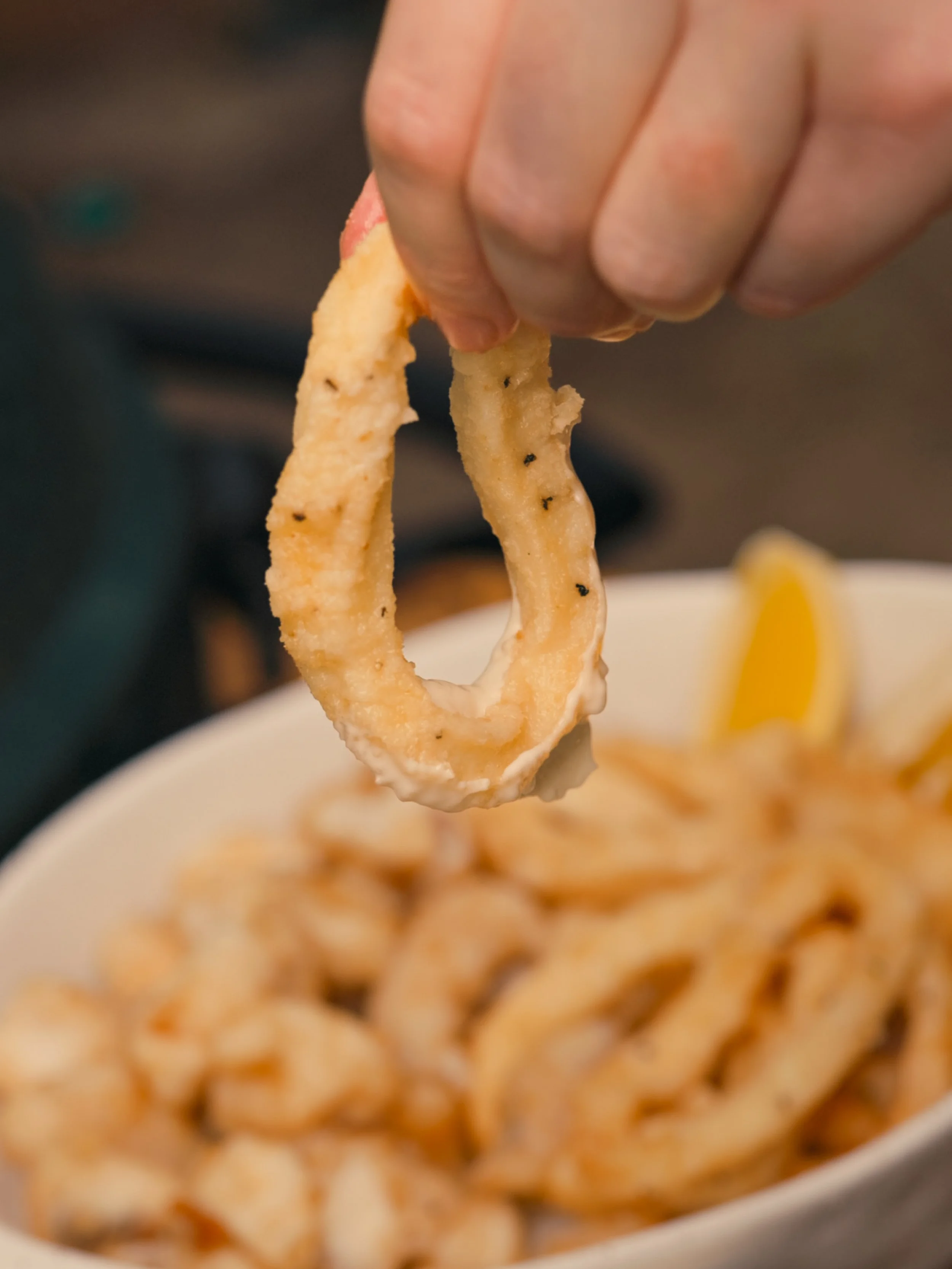Salt and Pepper Nibble Plate
There’s something about a plate of crisp seafood that pulls everyone in. You don’t need to announce it. People just know. They wander over, start with one piece, then another. Suddenly, the platter’s empty, and you haven’t even sat down.
That’s what this recipe is. A simple salt and pepper nibble plate — flathead and calamari cooked fast, clean, and golden. It’s everything you love about seafood without the fuss.
You’ll use fresh fillets and rings, the kind that smell like the ocean, not the freezer. You’ll coat them lightly, fry them quick, and let the ingredients do the talking.
Why this recipe works
Fresh seafood doesn’t need rescuing. It just needs a bit of confidence.
When you buy it straight from the market, you’ll see how glossy and firm it looks — that’s your first clue it’s going to cook beautifully. Frozen seafood can taste fine, but it never behaves the same. Once it thaws, it releases water, and that’s what turns the coating soggy.
Flathead and calamari are forgiving when they’re fresh. They fry evenly, stay tender, and don’t need a marinade. The magic happens in the oil.
At around 180°C, the coating locks in moisture while the surface bubbles and sets. Calamari takes about 90 seconds; any longer and it turns tough. Flathead needs about two to three minutes — just until the colour turns golden and the smell of clean salt air hits you.
It’s the kind of cooking that teaches you patience and instinct. You watch. You listen. You know when it’s ready, not because of a timer, but because it looks and sounds right.
Key Take Away
This isn’t the kind of recipe you follow once and forget. It’s one you’ll keep coming back to. The method’s simple, but it teaches you something every time you make it — patience, timing, and the quiet reward of getting it just right.
When you hear that first crunch, you’ll know exactly why it works.
Ingredients
For the Salt and Pepper Nibbles
400 g fresh flathead fillets, cut into bite sized pieces
300 g cleaned calamari rings
½ cup plain flour
½ cup rice flour
1 tsp sea salt
1 tsp cracked black pepper
½ tsp garlic powder
Oil for deep frying (peanut or vegetable)
Lemon wedges, to serve
Serves: 4 Prep Time: 15 mins Cook Time: 5 mins Total Time: 20 mins
Step 1: Preheat the Grill
Fire up your grill and bring it to a consistent 200°C. Pour oil into a deep pan until it’s about 5 cm deep. Bring it up to 180°C. You’ll know it’s ready when a pinch of flour sizzles but doesn’t burn.
Step 2: Mix the Coating
Combine both flours, salt, pepper, and garlic powder in a shallow bowl. Keep it dry and light. You want a fine dusting that clings, not a heavy batter.
Step 3: Coat the Seafood
Pat your flathead and calamari dry with paper towel. Toss each piece in the flour mix until evenly coated. Shake off the extra — too much flour dulls the crunch.
If your calamari isn’t freshly caught, soak it in milk for 20 minutes before coating. The mild acidity helps tenderise it and keeps the texture soft once fried. Drain and pat dry before dusting in flour.
Step 4: Fry in Small Batches
Start with the calamari. Drop it in gently and watch the edges curl and crisp. After 90 seconds - 2 minutes, lift it out and let it rest on paper towel.
Next, add the flathead strips. Fry for 2–5 minutes, turning once, until golden and light.
Keep each batch small so the oil stays hot. Temperature is everything here.
Step 5: Finish and Serve
Move everything to a platter while it’s still hot. Add a pinch of salt, a few cracks of pepper, and a generous squeeze of lemon. That’s it.
Tips for Perfect Results
What to Serve
You can’t go wrong with a chilled glass of white wine or a cold beer. Keep the sides simple — Grilled Corn with Lime Butter or a Smoked Potato Salad balance the salt perfectly.
If you’re cooking outdoors, make it part of a bigger spread. Add Scallops on the Shell with Champagne Butter for a touch of indulgence.
Tips for the Perfect Seafood
Buy it fresh. You’ll taste the difference. Frozen seafood works, but fresh gives you that tender, clean bite.
Use rice flour. Plain flour adds structure; rice flour gives you the crisp edge. Together, they balance texture.
Control the heat. 175°C to 185°C is your range. If the oil cools down, wait. It’s better to pause than ruin a batch.
Eat it hot. Fried seafood waits for no one. The crunch fades fast. Serve it as soon as it hits the plate.
Storage
It’s best eaten fresh, but if you need to reheat, use a 200°C oven for 5 minutes. Don’t microwave it. The coating will soften, and you’ll lose the texture that makes it special.
FAQ
-
Yes, but pat it dry. Expect a slightly softer result.
-
Peanut or grapeseed oil. Both have high smoke points and clean flavour.
-
You can, but it won’t taste the same. Brush with oil and air fry at 200°C for 6–8 minutes for a lighter version.
-
Plain flour adds body. Rice flour crisps fast and stays light. It’s the secret to that whisper-thin crunch.
-
Two things matter — heat and prep. Cook it hot and fast, under 2 minutes in oil at 180°C. If you’re using previously frozen or day-old calamari, soak it in milk for 15–20 minutes first. The milk tenderises the flesh gently, helping it stay silky when fried.

